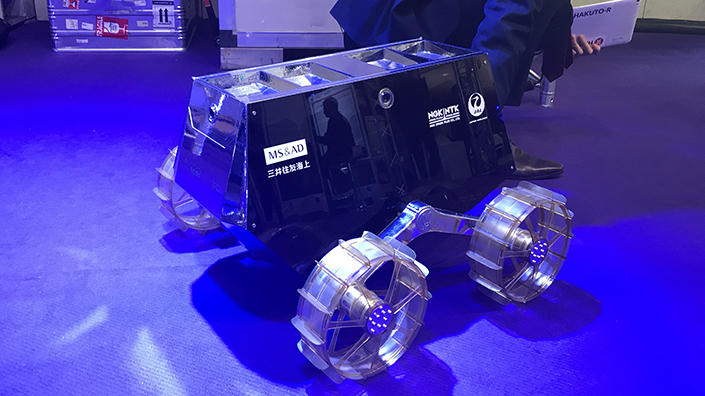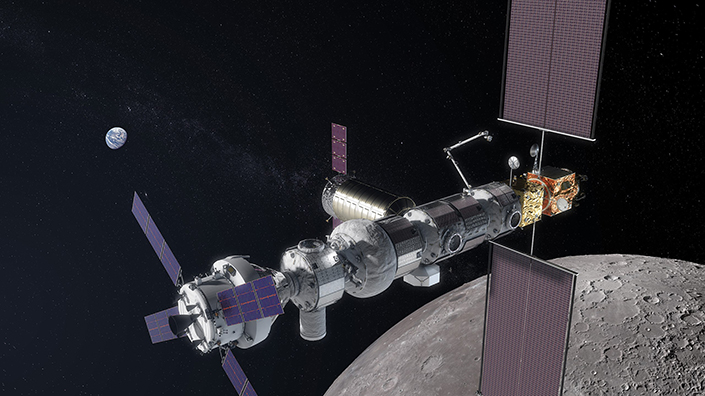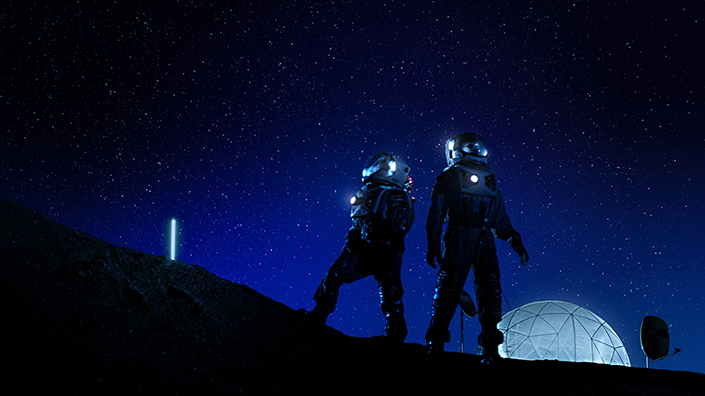What, though, will the next Moon landings look like? There have of course been several manned and many unmanned landings since Apollo 11 50 years ago, but the next missions could be era-defining as humanity extends further beyond its celestial neighbourhood.
The superpower space race of the 1960s has been replaced by a capitalist star wars, bringing a previously unprecedented range and variety of technology to the final frontier. Here are four of the engineering concepts and designs that could one day be as iconic as the Columbia command module.
Robotic prospectors

An ispace rover at the Paris Air Show
Scientific, political and existential reasons are compelling human missions to Mars – and beyond. Going further than the Moon will require a lot of fuel, however. ispace thinks it might have the solution.
Water ice has been identified at the lunar poles and could be incredibly important for sustaining life during future manned missions. It could also be split using solar or nuclear energy, providing oxygen for breathing and hydrogen for rocket fuel. This process could be vital for long-distance space missions.
Multinational ispace aims to quantify this water resource at the lunar south pole, deploying its miniature rovers in 2023. The 8kg, solar-powered robots will use spectrometers and radar to identify water beneath the surface, mapping it with a resolution of 1m.
The ultimate aim, says business developer Antoine Bocquier at the Paris Air Show, is to build a “lunar economy”. Robot ‘swarms’ could follow the miniature rovers to extract the water, and the company is working with mining experts to explore the best extraction of the Moon’s precious resource.
Amazon in space

The Blue Moon capsule (Credit: Blue Origin)
NASA’s Artemis programme hopes to land humans on the Moon’s surface once again in 2024. When it does so, it will likely be reliant on some new commercial partners.
Several organisations have already presented lander concepts, including Lockheed Martin – whose predecessor Lockheed Propulsion Company developed the Apollo 11 launch escape motor and the pitch control motor for the Apollo spacecraft – and Blue Origin, founded in 2000 by Amazon boss and world’s richest man Jeff Bezos.
The company unveiled its autonomous Blue Moon lander earlier this year, a multi-purpose vehicle capable of delivering cargo, rovers, base infrastructure and potentially even people to the surface. It will be powered by hydrogen and oxygen, meaning it could take advantage of mined lunar water.
The mid-2020s could bring the sight of Amazon’s empire extending to the lunar surface. Bezos’ passion for lunar exploration has been criticised by some as over-zealous, however, with some suggesting his billions might be better spent solving problems on Earth.
Gateway to the Moon

The Gateway in lunar orbit (Credit: NASA)
The Artemis programme also includes the controversial Gateway, previously known as the Deep Space Gateway and Lunar Orbital Platform Gateway. Orbiting the Moon, the space station is intended to be a research and exploration base for lunar missions and trips to Mars.
The Gateway is an ambitious collaboration, with NASA leading and contributions from the Russian, Canadian, Japanese and European space agencies. It will involve a number of private partners such as Airbus, which is developing refuelling, docking and telecoms infrastructure.
Missions to the lunar south pole will stop off at the platform, as will autonomous or manned crews heading further out into the Solar System. It will consist of at least six modules, including living areas for human crew, a logistics section with a robotic arm and an airlock module.
Lunar prefab

Could humans live on the Moon? (Credit: Shutterstock)
One of the next manned missions to the Moon could see humans staying on the surface considerably longer than the current record of 75 hours, set by Apollo 17’s Harrison Schmitt and Eugene Cernan in 1972.
The idea of permanent lunar bases is growing in momentum as humanity broadens its horizons, and a number of concepts have been proposed. Origami-like carbon fibre structures, converted craters and inflatable modules have all been proposed as housing for future explorers.
Microwaves could even be used to process lunar dust to build 3D-printed structures, according to the ‘Living on the Moon’ exhibit put together by five institutions at the recent Royal Society Summer Science Exhibition.
“I think discoveries made in the last five years have made it much more likely that we will see people going to the Moon for extended periods of time in the not too distant future,” said Open University researcher Dr Mahesh Anand. “There is definitely a global demand for this as many more powers enter the space race.”
Content published by Professional Engineering does not necessarily represent the views of the Institution of Mechanical Engineers.